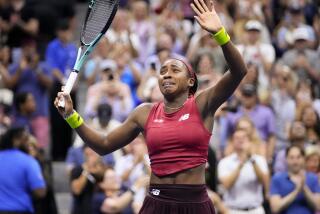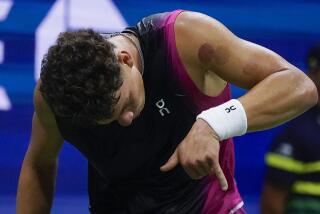Call It Service With a Smile : Tennis: Sampras gets 13 aces--giving him 100 for tournament--and upsets fourth-seeded Agassi for U.S. Open title.
- Share via
NEW YORK — The U.S. Open crowned its youngest men’s singles champion Sunday when 19-year-old Pete Sampras won his first Grand Slam title, the lightning in his racket flashing under a dirty gray sky.
Sampras, who grew up idolizing Rod Laver and dropped out of high school to chase his own tennis dream, scored the biggest upset in the U.S. Open men’s final since 1957 when unseeded Mal Anderson won the title.
Before 19,288 on a cool day, Sampras routed Andre Agassi, 6-4, 6-3, 6-2, in a 1-hour 42-minute display of serving prowess that seemed to numb even Sampras.
“It doesn’t seem real,” said Sampras, from Rancho Palos Verdes. “It’s going to take a while for it to sink in.”
Sampras, who had 100 aces in his seven matches, knocked 13 past fourth-seeded Agassi to send him to his second Grand Slam final defeat since June.
Agassi, who lost the French Open title to Andres Gomez, was asked to describe what happened to him.
“It’s not like I lost it, I got my . . . kicked,” Agassi said. “That’s about it.”
Seeded No. 12, Sampras breezed through his seven matches, losing only three sets--one each to John McEnroe, Ivan Lendl and Thomas Muster.
“I was on kind of a roll and played really well from the first point on,” Sampras said. “I had absolutely no nerves or anything about being in my first Grand Slam final.
“It was great,” he said. “I had a great time out there.”
Sampras quickly made friends when he then announced that he planned to spend his $350,000 prize money on a giant cocktail party for the media.
For two weeks, the U.S. Open was just one big party for Sampras, who at 19 years 28 days old, replaced Oliver S. Campbell as the youngest U.S. Open winner. Campbell was 19 years 6 months when he won the men’s title in 1890.
Before Sampras, the lowest-seeded player to win the U.S. Open was 10th-seeded John Newcombe in 1973.
Sampras had never gone beyond the round of 16 in his eight previous Grand Slam appearances. Before his third-round match with Muster, Sampras said he was not ready to win a Grand Slam.
“I’m glad I proved myself wrong,” Sampras said.
Quite unexpectedly, the biggest weapon in the 110th U.S. Open was Sampras’ serve. He counted 111 service winners in addition to his 100 aces and unloaded on Agassi with a fury.
Sampras won 92% of his first serves, winning 35 of 38 points. Agassi claimed only 14 points on Sampras’ serve and had only three break point chances, missing them all.
Sampras gave every indication that if the 6-4, 6-3, 6-2, match had gone further, the next two sets would have been 6-1, 6-0.
He claimed the first set in 36 minutes, needing a single service break in the third game when Agassi sent a forehand long. It would be one of his 20 unforced forehand errors, but the first costly one.
Sampras aced Agassi twice to even the second set at 1-1 and blew three break points in the next game. Agassi wasn’t as lucky in the fifth game. Sampras got to break point with a stunning forehand service return down the line, then broke to 3-2 with a forehand volley winner.
Agassi was down, 5-3, when he served to stay in the set. Another forehand found the net to bring Sampras to set point, and he converted immediately with a backhand return down the line.
After 67 minutes, Sampras was up two sets and Agassi was shaking his head.
“He’s always had a big serve, but he’s put together some really exceptional placement on his serves the last couple of weeks,” Agassi said.
“If you looked at the (videotape), you’d see all his aces are on the line,” he said. “That’s just tough. The chances of returning serves that are hit 100 m.p.h. when it hits the line are slim, not to mention when he can blast one 120 m.p.h.”
Agassi’s only chance to get back in the match came early in the third set. Sampras saved two break points in the first game and another in the third, then broke Agassi at love for 4-2 with another backhand down the line.
“I thought he would go for more shots and winners, and he just seemed tentative,” Sampras said. “He wasn’t being the aggressor. He was letting me dictate play and I think that was the difference.”
Soon, play was over. Agassi, who said he would admit to being flat but didn’t want to take any credit away from Sampras, walked to the baseline to serve at 2-5.
Agassi fell behind, 0-30, but forced deuce twice before back-to-back forehands found the net. When the last one ended there, at 6:02 p.m. EDT, Sampras raised his arms in triumph, and, smiling, turned to the seats where his coach, Joe Brandi, was standing.
“This is way ahead of where I thought Pete would be,” Brandi said. “But I guess he’s just a little ahead of my timetable.”
Agassi shook hands with Sampras over the net, then pulled him closer and whispered something in his ear.
“I told him he deserved it,” said Agassi, who described the outcome as “a good old-fashioned street mugging.”
Agassi acknowledged that he could have played better, that he was hitting the ball well enough, but also that Sampras decided the match, he didn’t.
“When someone is just beating you like he was, there’s not a whole lot to get frustrated about,” Agassi said.
“Anything he touched turned to gold out there,” Agassi said.
After beginning the year ranked No. 81, Sampras entered the U.S. Open No. 12, but he will be No. 6 when the new IBM/ATP rankings are released today.
It was only five years ago that Sampras changed from a two-handed backhand to a one-handed backhand and became a serve-and-volley player instead of a counter-puncher.
Looking back, if someone had told him at the beginning of the year that he would win the U.S. Open in September, Sampras had a ready response.
“I would have said you’re pretty crazy,” Sampras said.
But what happened then? It’s pretty simple, actually.
“The way I played today, I really don’t know if anyone could have beaten me,” Sampras said.
U.S. Open Notes
Jana Novotna and Helena Sukova, who were looking for the Grand Slam of women’s doubles, didn’t find it. The second-seeded team of Gigi Fernandez and Martina Navratilova defeated the top seeded team in straight sets, 6-2, 6-4. It was Navratilova’s 31st major doubles victory. “We didn’t want them to win the Grand Slam by beating us and (we) become a trivia question,” Navratilova said.
SWEET SERVICE Pete Sampras, 19 years and 28 days, became the youngest U.S. Open champion Sunday with a straight-set victory over Andre Agassi. For Sampras, the foundation of his first Grand Slam title was built on his strong serve, the fastest clocked in the 120-m.p.h. range. Sampras finished with 100 aces. Coupled with 111 service winners--serves the other player touches with his racket but cannot return--Sampras’ serves were the story of the U.S. Open.
Opp. Score Aces SW* Goldie 6-1,7-5,6-1 9 10 Lundgren 6-4,6-3,6-3 16 12 Hlasek 6-3,6-4,6-1 6 11 Muster 6-7,7-6,6-4,6-3 15 18 Lendl 6-4,7-6,3-6,4-6,6-2 24 27 McEnroe 6-2,6-4,3-6,6-3 17 21 Agassi 6-4,6-3,6-2 13 12
* Service winners
More to Read
Go beyond the scoreboard
Get the latest on L.A.'s teams in the daily Sports Report newsletter.
You may occasionally receive promotional content from the Los Angeles Times.










